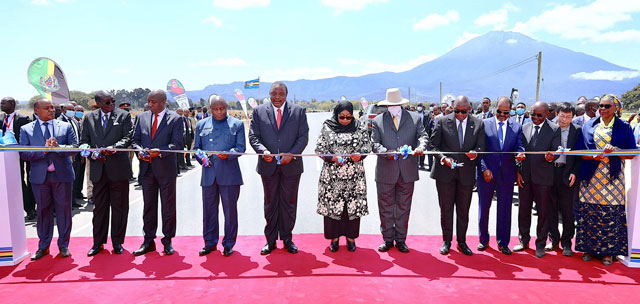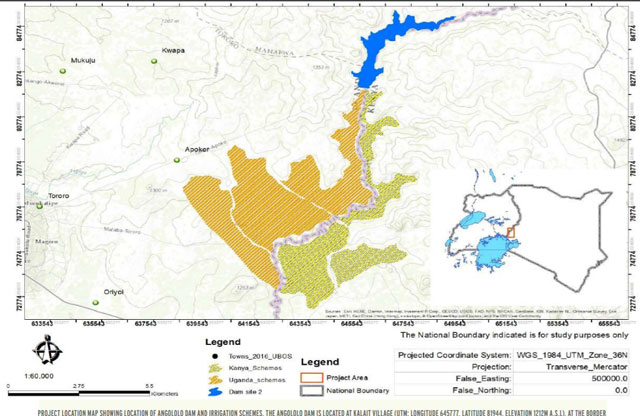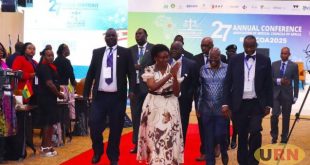



Arusha, Tanzania | THE INDEPENDENT | Kenya’s President Uhuru Kenyatta has handed over leadership of the East African Community to Burundi’s Évariste Ndayishimiye at the 22nd Ordinary Summit of Heads of State at the EAC headquarters in Arusha, Tanzania.
He outlined several success his term has registered including the endorsement of the construction of the USh224 billion Angololo Irrigation and Water Resources Development Project that will benefit 127,000 people in Uganda and Kenya.
“The project will irrigate 3,300 hectares of farmland, and supply water to 20,000 households in Busia and Bungoma counties of Kenya and Tororo district of Uganda. It will also generate 1.75 megawatts of hydropower,” he said earlier today.
The Angololo Water Resources Development Project (AWDP) is located on the trans-boundary Malaba River that is between Kenya and Uganda and it falls within the Sio-Malaba Malakisi (SMM) River Basin within the Lake Victoria sub basin.

The project consists of a proposed 30 metre high dam with a reservoir capacity of 43.0 million cubic metres that will supply potable water to 20,000 people and irrigate 3,300 hectares (1,180 Ha in Kenya and 2,120 Ha in Uganda). .
The project has a catchment area of 430 kilometres squared. In total the Angololo Water Resources Development Project is expected to benefit at least 127,300 people from Tororo, Manafwa, and Namisindwa districts in Eastern Uganda and Busia and Bungoma Counties in Kenya through
employment creation, irrigated agriculture, piped water supply, hydropower generation, and livestock
and fisheries production.
The other key EAC achievements during Kenyatta’s tenure is the ratification of the African Continental Free Trade Area (ACFTA) ambitious trade pact by all EAC states and the deepening of financial integration where indigenous banks adopted a regional business model motivated by client-demand.
Achievements included the declassification of the seas along the East African coast by Kenya, Uganda and Rwanda to reduce the cost of insurance and shipping and lower the cost of doing business through the ports of Lamu, Mombasa and Dar es Salaam.
President Kenyatta said it was also during his tenure at the helm of the EAC that Kenya and South Sudan waived the visa requirements for both their citizens.
“In line with Article 10 of the EAC Common Market Protocol, the two partner states committed to allow workers from each of their countries to accept employment within each other’s territory. South Sudan and Uganda also waived visa requirements for their nationals,” the President said.
In his address Friday, Kenyatta urged East African Community (EAC) leaders to fast-track implementation of programmes and projects that will deliver quick results for the benefit of EAC citizens.
Acknowledging the progress the EAC has made since its re-establishment more than two decades ago, the President emphasized the need for the leaders to remain focused on the goals of the community to meet the desire for an inclusive, equitable and responsive integration process that addresses the daily needs of the EAC residents.
“The citizens are looking to us to fast-track and implement programmes and projects that will transform our region. While the EAC is ranked as one of the most integrated regional economic communities (RECs) in Africa, our citizens are yet to enjoy the freedoms and rights of integration fully.
“Therefore, our responsibility at all leadership levels should be to ensure that the objectives of establishing the community are on course,” the President said.
Kenyatta stressed that the citizens of East Africa must be involved in all stages of the integration process by making them aware of what is happening in the community as part of ensuring inclusivity.
“While I appreciate the efforts being carried out by partner states as well as the organs and institutions of the community in sensitising the populace, I believe we can and should do more to ensure that the people of East Africa are not left behind in the integration process.
“Of equal importance are partnerships with all stakeholders in the integration process. Experience has shown that stakeholder partnership is the key to achieving sustainable development globally. As we move forward, we must invest in building collaboration with the private sector and development partners,” Kenyatta said.
The President recalled that while re-establishing the EAC, the leaders envisioned four pillars namely the Customs Union, the Common Market, the Monetary Union and the Political Federation to drive the integration process.
“Among them, the operationalisation of the Customs Union established in 2005 and the Common Market established in 2010 are on course. Albeit slow-paced, the community has also made significant progress in the Monetary Union whose protocol was ratified eight years ago,” the President said.
On the expanded EAC region, Kenyatta said he looked forward to the admission of Somalia into the regional economic bloc.
Somali President Hassan Sheikh Mohamud attended the summit as a special guest and observer. At the same time, Kenyatta was appointed by the East African Community to be the DR Congo peace process facilitator.
In his acceptance speech, President Ndayishimiye pledged to work closely with all EAC leaders to take the community to a higher level focused on improving the welfare of the EAC citizens.
In their remarks, host President Samia Suluhu Hassan and President Yoweri Museveni of Uganda commended Kenyatta for his visionary leadership of the EAC that saw the community record significant achievement during his tenure.
On his part, Somali President Hassan Sheikh Mohamud, who attended the summit as a special guest, affirmed his country’s commitment to joining the EAC community.
Others were speakers included Prime Ministers Édouard Ngirente of Rwanda and Jean-Michel Sama Lukonde of DR Congo who represented Presidents Paul Kagame and Félix Antoine Tshisekedi respectively while South Sudan President Salva Kiir Mayardit was represented by Minister Barnaba Marial Benjamin at the one-day summit.
EAC Secretary General Dr. Peter Mathuki and Kenya’s acting East African Community and Regional Development CS Betty Maina who is also the chairperson of the EAC Council of Ministers also spoke at the summit held under the theme “EAC: Deepening Integration, Widening Cooperation”.
Earlier, President Kenyatta and President Samia Suluhu Hassan presided over the official opening of the 42.4 km Arusha Bypass road, one of the three regional road projects that have benefitted Arusha, the EAC headquarters.
The others include the 14km Arusha-Tengeru dual carriageway which is part of the Arusha-Holili-Taveta-Voi road and the 243km Arusha-Namanga-Athi River road which was completed and inaugurated by EAC leaders in 2012.
****
SOURCE: PPU KENYA
 The Independent Uganda: You get the Truth we Pay the Price
The Independent Uganda: You get the Truth we Pay the Price



